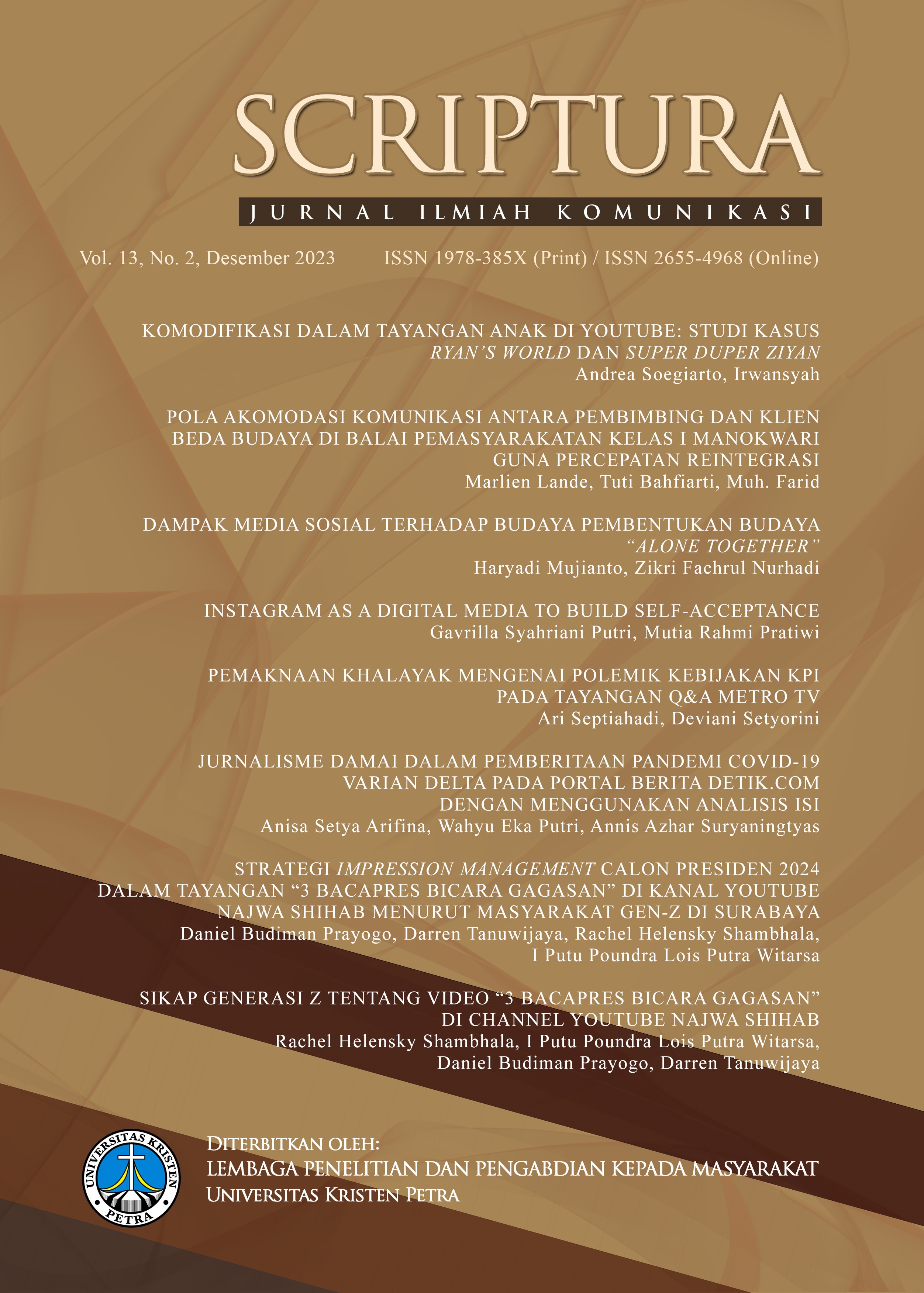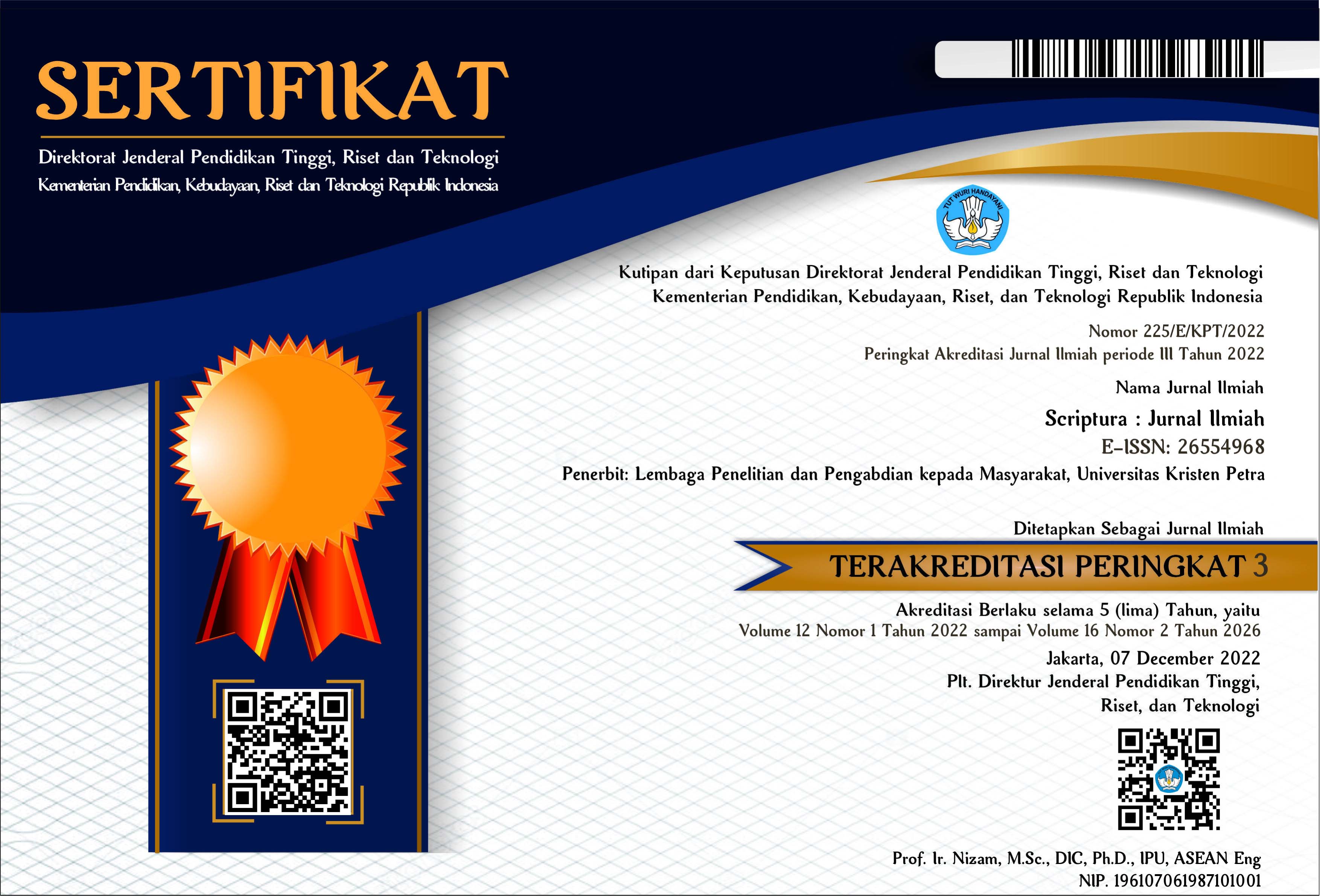Dampak Media Sosial Terhadap Budaya Pembentukan Budaya “Alone Together”
 :
:
https://doi.org/10.9744/scriptura.13.2.120-128
Keywords:
Media social, tiktok, whatsapp, budaya alone togetherAbstract
Bermedia sosial merupakan salah satu aktifitas yang menunjukkan gaya hidup masyarakat di era digital. Media sosial memberikan manfaat besar bagi para penggunanya dalam hal akses informasi, pemesanan transportasi, pesan instan, bahkan untuk keperluan hiburan. Fenomena yang terjadi adalah perubahan perilaku dan aktifitas pada para pengguna media sosial. Seringkali ditemui kelompok yang sedang mengalami “alone together” atau “sendiri bersama” di tengah keramaian. Penelitian ini bertujuan untuk mengetahui dampak media sosial terhadap pembentukan budaya “alone together”. Penelitian ini menggunakan pendekatan deskriptif kuantitatif dan verifikatif. Pengumpulan data dilakukan dengan menyebarkan kuesioner terhadap 100 orang responden mahasiswa Universitas Garut. Sampel diambil berdasarkan kategori non purposive sampling. Analisis data menggunakan regresi linier sederhana dengan bantuan software IBM SPSS 20.0. Hasil penelitian menunjukkan bahwa terdapat dampak yang signifikan dari media sosial terhadap pembentukan budaya alone together dengan besaran koefisien determinasi 67,5%, sedangkan sisanya 32,5% dipengaruhi oleh variabel lainnya.
References
Akhtar, A., & Haq, A. (2021). Social Media Addiction: The Rising Concepts and Issues. Journal of Peace, Development and Communication, 5(2), 100-110. doi: https://doi.org/https://doi.org/10.36968/JPDC-V05-I02-09
Akram, W., & Kumar, R. (2017). A Study on Positive and Negative Effects of Social Media on Society. International Journal of Computer Sciences and Engineering, 5(10), 347-354. doi: http://dx.doi.org/10.26438/ijcse/v5i10.351354
Amanda, N. R. (2020). Social Interaction Among Adolescents Who Use Social Media. Advances in Social Science, Education and Humanities Research, 395, 112-117. doi: http://dx.doi.org/10.2991/assehr.k.200120.025
Antoci, A., Sabatini, F., & Sodini, M. (2013). Bowling alone but tweeting together: the evolution of human interaction in the social networking era. Quality & Quantity: International Journal of Methodology, 48(4), 1911-1927. doi: http://dx.doi.org/10.1007/s11135-013-9863-z
Ardi, Z., & Putri, S. A. (2020). The analysis of the social media impact on the millennial generation behavior and social interactions. Southeast Asian Journal of technology and Science, 1(2), 70-77. doi: https://doi.org/10.29210/ 81065100
Ardi, Z., & Sukmawati, I. (2019). The Contribution of Social Media and Mobile Application to Individual Subjective Well-Being in Counseling Perspective. Journal of Counseling and Educational Technology, 2(1), 33-41. doi: https://doi.org/10.32698/0571
Borrero, J. D., Andrade, A. D., & Urquhart, C. (2013). Social Movements On The Internet: Together Alone Or Alone Together? Proceedings of the 21st European Conference on Information Systems. doi: 10.13140/2.1.3741.7924
Chukwuere, J. E. (2021). The Impact Of Social Media On Students' Social Interactions. Journal of Management Information and Decision Sciences, 24(7), 1-15.
Donlevie, K. (2018). Screen Time Versus Face Time: How Social Media Usage Affects Time Spent Face to Face. Sociology Senior Seminar Papers, 5.
Kietzmann, J. H., Hermkens, K., McCarthy, I. P., & Silvestre, B. S. (2011). Social media? Get serious! Understanding the functional building blocks of social media. Business Horizons, 54(3), 241-251.
Kolhar, M., Nazir, R., Kazi, A., & Alameen, A. (2021). Effect of social media use on learning, social interactions, and sleep duration among university students. Saudi Journal of Biological Sciences, 28, 2216-2222. doi: https://doi.org/10.1016/j.sjbs.2021.01.010
Morrow, J. (2020). Alone Together: Finding Solidarity in a Time of Social Distance. Space and Culture, 23(3), 315–319. doi:https://doi.org/10.1177%2F1206331220938643
Nasrullah, R. (2016). Media Sosial: Perspektif Komunikasi, Budaya, dan Sosioteknologi. Bandung: Simbiosa Rekatama Media.
Pan, Y., Coleman, L., & Goodof, S. M. (2019). Effects of Social Media Usage on Social Integration of University Students. International Journal of Technology in Teaching and Learning, 15(1), 1-17. Retrieved from https://eric. ed.gov/?id=EJ1276104
Saleh, G., & Pitriani, R. (2018). Pengaruh Media Sosial Instagram dan WhatsApp Terhadap Pembentukan Budaya “Alone Together". Jurnal Komunikasi, 10(2), 103-114. doi: http://dx.doi.org/10.24912/jk.v10i2.2673
Setiadi, E., Devitoyani, S. R., & A. I. (2021). Alone-Together Mediation in Correlation between Social Media Usage and Face-to-Face Communication of Millennials. Technium Social Sciences Journal, 25, 93-107. doi: https://doi.org/10.47577/tssj.v25i1.5107
Turkle, S. (2011). Alone Together: Why Expect More From Technology andLess From Each Other. New York: Basic Books.
Yavich, R., Davidovitch, N., & Frenkel, Z. (2019). Social Media and Loneliness - Forever connected? Higher Education Studies, 9(2), 10-21. doi: https://doi.org/10.5539/hes.v9n2p10
Yohanna, A. (2020). The influence of social media on social interactions among students. Indonesian Journal of Social Sciences, 12(2), 34-48. doi: http://dx.doi.org/10.20473/ijss.v12i2.22907
Downloads
Published
How to Cite
Issue
Section
License
Copyright (c) 2024 Haryadi Mujianto, Zikri Fachrul Nurhadi

This work is licensed under a Creative Commons Attribution 4.0 International License.
Authors who publish in the SCRIPTURA Jurnal Ilmiah agree to the following terms:
Authors retain unrestricted copyright and full publishing rights. The authors grant the Publisher the right of first publication, with the work simultaneously licensed under the terms and conditions of the Creative Commons Attribution License (CC BY) that allows for unlimited use, distribution, and content reproduction on all media as long as the original author and source are properly acknowledged and cited.


















